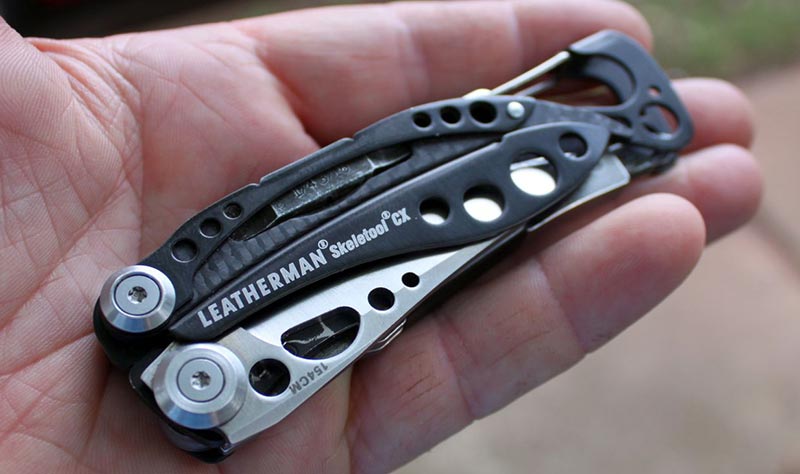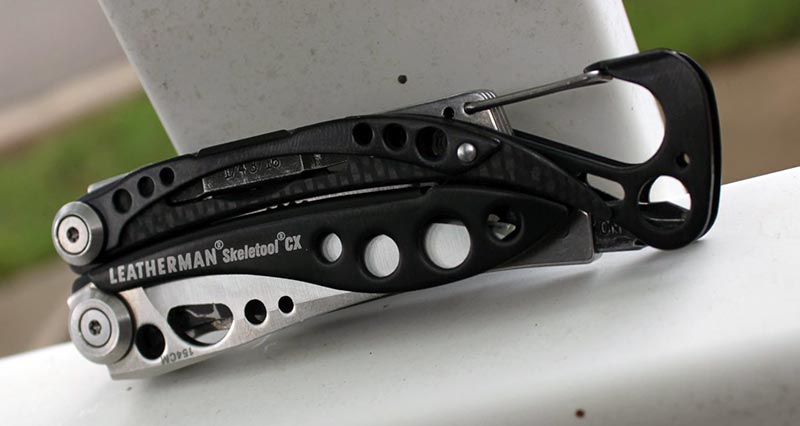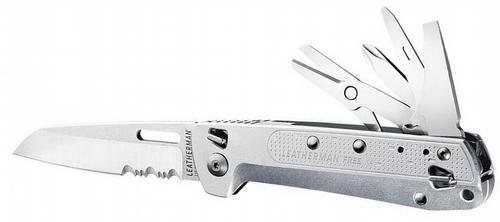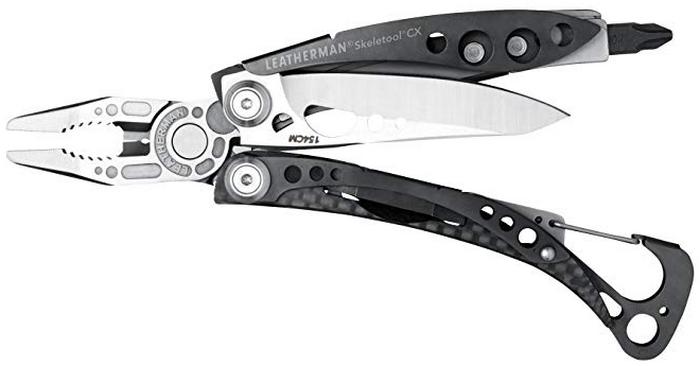We independently evaluate all recommended products and services. Any products or services put forward appear in no particular order. If you click on links we provide, we may receive compensation.
There’s something you should know about me. Knives are a beloved hobby and obsession, as evidenced by a pile of them carefully cleaned and laying in a lock box in my closet. Multitools are more like a life requirement. We talk about our “EDC loadout” but there’s only one true EDC item in my life beyond my wallet – that is to say, an item I literally carry every day: when I’m at work, it’s a Leatherman.

I’ve had another Leatherman – the Skeletool CX, the subject of this review – for a number of years, and it has an altogether different purpose in life. While the Skeletool and the Charge are the same overall length closed, the Skeletool is a full 3.3 ounces lighter than the Charge, and it fulfills more of a minimalist EDC role than a pocket toolbox role. It’s not as heavy– or as heavy duty – as the other full sized Leatherman models. In fact, it can be reasonably used as a single-item replacement for both a knife and a multitool in your EDC, offering both in one five ounce package. So we’re going to examine if the Skeletool CX is actually all things rolled into one, or just a jack of all trades and master of none.
The Blade
One thing the Skeletool CX has over many other multitools – and over the standard, much cheaper Skeletool – is a real knife. It’s not huge, but it’s what I consider real. By real I mean it’s made with an EDC-worthy stainless steel and it’s not partially serrated. This is the big issue with the standard Skeletool – using half of the small 2.6” blade for some partial serrations leaves you with hardly any cutting surface of either variety. Neither fish nor fowl, no thanks.

But the Skeletool CX has a drop point blade in 154CM steel – it’s no CPM S110V or 20CV, but it’s a big step up from the 420HC that is used in the standard Skeletool and most of the other Leatherman products. It has a series of small decorative (weight reduction?) holes drilled through it and an oddly shaped half-moon thumb hole for one-handed opening. It’s made from fairly narrow blade stock (0.10”) to keep the stacked height of the tool low, and it has a partial flat grind for slicing ability. The shape is a modified drop point with a concave portion to the spine (for your thumb to press down on) and it’s quite useful for day to day tasks. There are some quality issues with the blade, but we’ll get to that later.
Deployment and Lockup
There are two types of deployment and lockup to consider here – the blade is really just an accessory with a big handle, the pliers are the main tool.

Since this is Knife Informer and not Pliers Informer, we’ll start with the knife first. It’s one hand opening and it’s accessible from the outside (meaning the pliers don’t have to be unfolded first, a common complaint with a lot of multitools like the original Leatherman PST and SuperTool) so you can slip the Skeletool out of your pocket and open the knife up just like it was a normal pocketknife. So far so good.
The Skeletool’s blade rides on a single phosphor bronze washer between its inner surface and the main frame plate, and the outer surface rides directly on the washer and nut that holds the whole tool together. This single sided washer arrangement means there’s some friction when opening and it’s important to keep the knife pivot oiled for smoothness. You can roll the knife open with your thumb, but it’s not really able to be “flicked” open – if you really practice a lot and you’ve just shot some oil in there, maybe. But it’s not intended for that. Messing with pivot tension of the main body bolts is a bad idea – it introduces play to the pliers as well as the blade.

Lockup is via a stainless steel liner lock which also includes a molded detent ball that holds the blade closed. I have no complaints about the lock considering the intended purpose of the knife – this is for small day-to-day cutting tasks, not batoning through a Jeep. The liner engages fairly deep on the tang – probably 60 percent or so – but there’s no vertical blade play. There is slightly horizontal blade play, but it’s hard to tell if it comes from the lock or from the pivot – it feels more like flex than a rocking motion. There is no stop pin per se, but the knife uses the outer scale that covers the blade in the closed position to locate the blade in the open position.
The other half of deployment is the opening action of the handles themselves to access the pliers. Compared to something like the Charge, the pliers are quite stiff as they’re actuated by a series of slipjoints that hold the tool closed and open. I’ve had and used the Skeletool for several years now and it’s never even approached one handed opening for the pliers – although my Charge has loosened up to the point that I can flip it like a Balisong. I use both hands to open the pliers, grabbing the wing that covers the blade with my left hand and the carabiner/bottle opener section with my right to pull outwards. There is a very pronounced “snap” when the slipjoint drops into place in the open position on both sides, and this is not a tool that will unintentionally fold shut thanks to the strong tension. Also, both sides operate independently – which is important as we’ll get to in the next section.
Features, Fit & Finish
Obviously, the Skeletool has a lot more features than your typical pocketknife, so we’ll dig into that first. This is a “pliers-based” multitool – which means it’s primarily pliers and everything else is additional, the structure of the tool being based around the function of the pliers. Leatherman packs a lot of functionality into their pliers, combining needle nose pliers (at the tip) with regular pliers (in the center, typically for turning nuts) as well as both regular wire cutters (the broad flat portion inside of the regular pliers) and hard wire cutters (at the very base of the pivot.) This tool doesn’t include replaceable hard wire cutter inserts like newer full size Leatherman do, but it’s not really intended as an electrician’s tool.

There is also a full-sized bit driver built into the thinner handle, opposite of the carabiner/bottle opener. It uses Leatherman’s proprietary flat two-sided bits also used on other models like the Wave, Charge, Surge, MUT, and Signal. The Skeletool includes a tension-fit slot in the opposite handle to hold an additional bit, and the tool comes with two – one is a #1 and #2 Phillips, the other being a ¼” and 3/16” straight screwdriver. The bit driver has a sprung latch with a single tooth that holds the bits in place, lining up with a notch in the bit. You can fit any other flat bits in the slot, so if you have a bit kit you can pick which are most useful to you.
Of course, there’s also the combination carabiner/bottle opener on the end which also serves as a cover for the bit driver in the closed position. It has a sprung wire gate and an angled tab for removing bottle caps as well. Other features include a pocket clip (single position) on the back side that’s held by a single screw and a dowel to locate, and a slick little carbon fiber scale on the show side. Markings include “Leatherman Skeletool CX” printed on the front side outer scale (which covers the edge of the blade) and “154CM” on the blade, and “Leatherman” embossed on the plier head.

Fit and Finish is a touchy subject on Leatherman tools. I appreciate the design and manufacturing that goes into making such complex things at affordable prices (this tool has a $79.95 MSRP) but I wish Leatherman spent more time on quality control. The blade grind is frankly awful, with a spot on the lock side of the blade towards the tip that looks like someone sneezed while they were using a blade grinder. It becomes immediately apparently that the edge bevel itself isn’t level when you sharpen the knife for the first time. The show side of the blade rubs the scale in the closed position even with the screw tightened all the way down. The finish on the spine of the blade is also a bit rough, and the exposed blade tang is far too sharp.
The tips of the pliers are ground asymmetrically – the tip on the carabiner side is a much shallower angle than the other – but I’ve never been able to figure out if that’s intentional for clearance reasons. Still, the tips meet evenly and the jaws of the plier are level. The primary “frames” of the tool are folded stamped steel liners that are painted black, which tend to wear off with pocket carry. Several rainbow-colored welding spots can be seen underneath the edge of the blade in the closed position. Do any of these QC issues effect performance? Not really.
Field Test
As mentioned, I’ve had the Skeletool CX for a few years and used it occasionally, but when I decided to do this review I did something unusual: I put away all of my folding knives as well as my full sized Leatherman, and only carried this tool both at work and at home for several weeks. The idea was to see if the Skeletool can actually replace both a pocket knife and a multitool in your EDC with one item, and how well it serves both purposes at the same time.

One of the most impressive things is how well the Skeletool carries in pocket. Obviously it’s not going to carry as well as, say, the Kizer Feist. It is a multitool after all. But the full sized pocket clip lets the Skeletool ride fairly deep in the pocket, and the whole tool only weighs five ounces – that’s less than a lot of full sized folding knives! Because the clip is situated to leave the pivots facing upward, your hand has to pass around the thicker part of the tool to get a hold of it, including the exposed tang of the blade which is fairly pokey.
The Skeletool does take up a good bit of pocket real estate, meaning you’ll probably want to carry your cell phone in your left pocket so both can fit, and it can sometimes get in the way of accessing smaller items in the bottom of your pocket. However, since the heavier part of the tool is closest to the clip it avoids turning the pliers head into a pendulum in your pocket, as well as the clip creating a hot spot on the handle with the pliers open. Some real thought went into the design of the clip being where it is.
The carabiner is also a workable carry solution if you’re attaching the Skeletool to something like a D-ring on a bag. You can clip it to your belt loops if your pockets are full, but it swings and bounces around and you’ll look like an insufferable dork. The Skeletool is much too heavy to clip to your keys – don’t do that. Haven’t you heard what happened to the Chevy Cobalt? Be careful.

So there are three ways to open the Skeletool CX. The first is just the blade itself. Because of the proportions of the tool, it’s very much handle-heavy compared to the length of the blade, which means you can get a full hand grip despite having a short blade. Some reviewers may bemoan a high handle-to-blade ratio but I find it to give you better control over the blade – more handle and less knife means more leverage on the knife. You’d think this would be an ergonomic mess but actually it’s a fairly comfortable knife handle. The slipjoints that hold the pliers are cut away in an arc where your forefinger sits, and the handle behind it is rounded to accommodate your other three fingers. You can easily fit your thumb on the spine of the blade for leverage as well.
Despite basically disappearing into the handle when closed, the Skeletool does something no other pliers-based multitool does: the knife feels like a real knife. Not even my Charge can pull this off, feeling like an ice pick stuck on a TV remote when you’re trying to cut things. You can ignore that the Skeletool also contains pliers, a screwdriver and a bottle opener and just remark that it’s a useful knife with a comfortable handle. And the knife itself is great: just large enough to handle light day to day tasks, with a useful blade shape and easy one handed opening and closing. It also holds an edge quite well for 154CM steel, too. It’s great for EDC use.
The second way you can open the tool is just the bit driver side. Holding the carabiner in your left hand and pinching the frame with your right finger and thumb lets you open just one side of the handle to extend the bit driver. Since the bit driver is built into the end of the handle, you don’t need to do the two step open-and-fold-out like the Charge and Wave require. Being able to open the handles separately and them to snap into place effectively turns the Skeletool into a long, slightly offset screwdriver – it can reach into deep spots that the aforementioned Wave and Charge cannot, and attempting to operate those tools in this manor would have the handles waving wildly all over the place as they lack the slipjoint mechanism. It’s a fairly effective screwdriver for your typical Philips and straight screws you find around the house, although doing a lot of heavy work with it could be irritating due to the offset of the handle to the driver. I find it more comfortable to operate with the pliers tucked into the carabiner side rather than the driver side because it gives you something more solid to grip.
Finally, the fully open position with the pliers deployed is arguable what these tools are all about. The curvature of the handles makes sense once you’re using the pliers – the carabiner side arm is concave to locate your fingers solidly, and the other side is convex to make it more comfortable for your palm. The pliers are narrow at the tip to use as needle nose for grabbing small objects, but you can also use the middle of the pliers to tighten or loosen nuts and bolts. I’ve successfully used the inner portion of the pliers to cut and strip wires for wiring repairs before – it requires a little practice to strip wires, but it works well for smaller (18-22ga) wires like those found in car electrical systems.

I found the Skeletool to be extraordinarily useful to have in my pocket during the time I carried it. I don’t normally carry a multitool when I’m at home, typically just carrying a pocket knife. You don’t realize what you’re missing out on until you start carrying a multitool – so many tasks are easily achieved with one tool around the house. The Skeletool is perfect for things like tightening retaining screws on cabinet knobs, opening doors to change air filters, trimming errant strings, cutting open food packaging, that sort of thing.
I found that the straight screwdriver bit’s small side is useful for depressing locking tabs on electrical connectors as well. I made a trip to the junkyard one weekend to pick up a few parts for my daily driver, and neglected to bring any tools home from work. Using just the Skeletool I was able to replace my car’s power antenna assembly (removing trunk trim using the screwdriver, loosening the mast retaining nut and the housing retaining bolt with the pliers, and opening the electrical connector with the screwdriver) as well as removing some dash switches and replacing their internal light bulbs.
I found over time that the knife is well suited to small tasks but I occasionally wished for a full sized knife for some things – like puncturing oil bottles, cutting cardboard, that sort of thing. I also found the handles on the pliers to be somewhat uncomfortable in extended use due to the odd shape and some sharp edges. But this isn’t a dedicated tool – it’s a lightweight minimalistic do-everything tool. It’s not going to work as well as the pliers on the Charge or cut things as well as a PM2. It does a good job of covering your needs at home but it’s not quite up to snuff as a dedicated work tool, which I think is what Leatherman was going for anyway.

One things that is superlative about the Skeletool? That bottle opener. I’m a man that enjoys the occasional beer, and the Skeletool quickly became my preferred bottle opener. Even better when it’s always in your pocket. Holding the tool over the top of the bottle and pressing the tip of the bottle opener down under the edge of the cap, you then use the leverage of the handle to push down and lift the cap off – and the sprung carabiner holds the cap too. Very convenient.
Alternatives
All these knives available at BladeHQ.
It’s difficult to define any alternatives to the Skeletool CX because it’s obviously not the same thing as a regular pocket knife, but it’s much lighter and more minimalistic than most multitools. It retails for $79.95 at time of writing.If you’re looking for a more traditional multitool, the Leatherman Rebar is similarly priced at $69.95 retail. It’s a derivative of the original style PST/SuperTool series (with all of the tools being inside-accessible only) and features a beefy heavy duty build that includes replaceable hard-wire cutters on the pliers. It doesn’t have the improved 154CM blade steel of the Skeletool, but it features both a plain edge and a serrated blade in 420HC steel as well as a full complement of other dedicated tools. It’s notably heavier at 6.7 ounces, and it lacks the useful 3D bit driver of the Skeletool, but it’s better suited to heavy duty use.

Want more knife in your multi-tool? The upcoming Leatherman Free K4 might be your style. It has an $89.95 MSRP and includes a 3.3” sheepsfoot blade in 420HC steel, as well as a bevy of useful tools that fold into the handle including sprung scissors, a Philips driver/bottle opener, an awl/extra small straight driver, and a pry tool/package opener/medium straight driver. Aluminum anodized handles and a deep carry pocket clip combine with the new Free line magnetic closing structure to make all the tools one hand openable.

Or, alternatively, for about $80 total you could buy a Leatherman Rev (which is the entry level option to the brand’s budget line which also includes the Wingman and Sidekick) for $42, and you can buy a CRKT Pilar for $30. The Pilar and the Rev combined weigh 10.8 ounces though.

Don’t want a Leatherman? The Victorinox SwissTool Spirit X is an often overlooked option in this market. It’s much more feature-heavy – and weight heavy, being about 50% heftier at 7.4 ounces. It does have a great set of pliers as well as a full complement of tools including scissors, a saw, and dedicated bottle and can openers as well as dedicated straight and Philips drivers. The Skeletool cuts a lot of weight by having these features be multi-function, like the bit driver and the combination carabiner/bottle opener. It must be said that while they don’t grab all the headlines, the Victorinox multitools are arguably the best-made tools in this segment.
Wrap-up
Leatherman has made the Skeletool and CX (and now some additional variants like the RX) for more than ten years, and they’ve been very popular the whole time. To me, this is because they actually offer something unique in the multitool segment. While most folding mulitools focus on packing as many features into a single piece (some Leatherman products claim 21 tools, the full size Victorinox SwissTool claims 29!) the Skeletool only has 7 functions. But they’re 7 functions that people ACTUALLY use every day. I mean really, how often do you use a file? Or an Awl? Or a gut hook? Basically never. But every tool, every part, every component on the Skeletool has been analyzed and designed to actually make your day to day life easier. Double-purposes tools that actually work, intelligent weight reduction, multiple carry options, a real knife, high end materials. The Skeletool makes a solid case for a single-tool solution to everyday carry…

And yet, it doesn’t. A full size multitool has much better pliers. A full size knife is much more ergonomic and useful. People like having options. All those useless gadgets on multitools are why people buy them and keep them around, in case they need to use an awl or a gut hook. A Multitool is meant to prepare you for “anything.”
If Multitools are trucks, and a Leatherman Surge is an F-250 Super Duty FX4 6.7 PowerStroke Diesel, then the Skeletool CX is a Toyota Tacoma SR5 4 cylinder with a 5-speed. Everyone wants a diesel ¾ ton truck for the two days a year they tow a boat, even though that’s about ¼ of the truck’s towing capacity. What everyone actually needs based on their usage is a four-cylinder Tacoma. But I don’t hear a lot of country songs about midsize pickup trucks (Russell Dickerson excluded). Still, if people are honest about what they actually do with their tools, a Skeletool CX will fulfill 99% of their needs 99% of the time. It’s a fantastic product, and I find myself recommending it to a lot of people all the time.
- The same weight as a lot of full sized knives but the added benefit of pliers, a bit driver, and a bottle opener/carabiner. Premium materials by multitool standards.
- Leatherman build quality leaves a lot to be desired, pricey, pliers uncomfortable for long term use, a multitool that’s not ideal for hard use seems like an oxymoron.
Leatherman Skeletool CX
Quality/Performance - 77%
Value for Money - 83%
80%
A multitool that does most of what you need to do most of the time without a lot of extra crap.
Words and Pictures: James Mackintosh.





